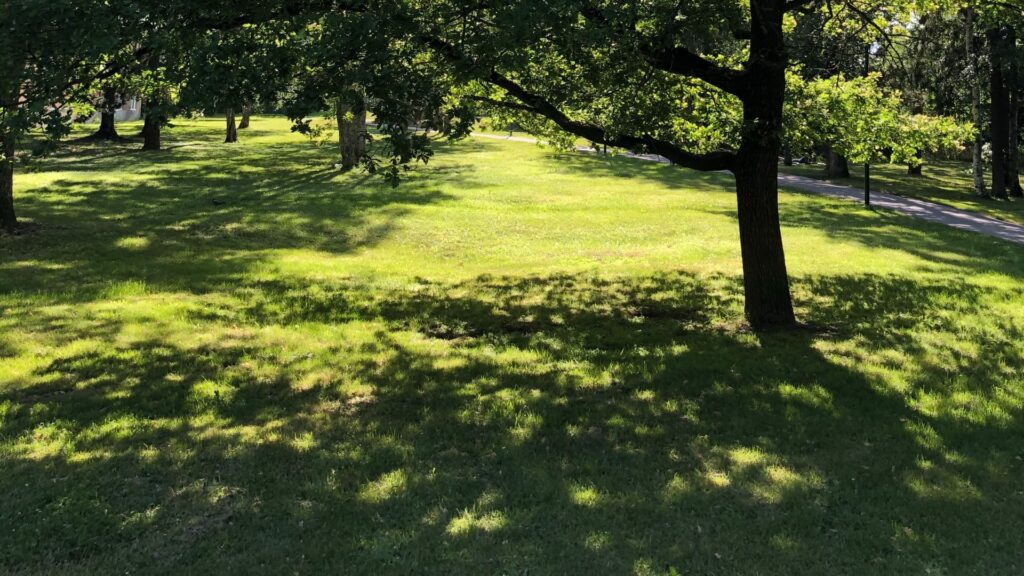The UK has just experienced its hottest day on record. Our summers are changing with heatwaves becoming more and more frequent. Still, most of the focus when planning a garden room is on keeping warmth in and not enough attention is given to keeping them cool.
Whether you’re still planning your garden room or are stood inside now realising there’s a problem, our guide to overheating will help you to create a space that’s cool this summer.
Table of Contents
Why do garden rooms overheat?
We have modern building standards to thank for overheating. Their intention is good of course; they aim to make garden rooms more energy efficient and to keep them warm in cooler climates. While that’s great for lowering energy bills, it has the side-effect of retaining unwanted heat.
Factors which contribute to overheating include:
- Solar gain
- Lack of ventilation
- Warm ambient air
- Heat generated by electronics such as TVs and computers
Overheating is a growing problem for all types of buildings in the UK, not just garden rooms. Then, we have climate change exacerbating the problem.
According to the Met Office, for example, the 10 hottest years on record in the UK all occurred since 2002. With a clear long term trend, the way we design garden rooms must adapt if they’re going to be a comfortable space throughout the year.
Design stage tips to prevent garden room overheating
Ideally, you should plan on how you’re going to tackle the heat before the build begins. There are certain things you can do during the design and planning phase that’ll make keeping your garden room cool that much easier.
Use natural shade to your advantage
The position of your garden room makes all the difference.
Pick the sunniest part of your garden and you’re setting yourself up for a toasty summer. Instead, try to position the building in a spot that gets some natural shade for at least some portion of the day.

But, what if you don’t have any natural shade? Decidious trees and shrubs, such as maple or ash, could be just the answer you’re looking for. Their leaves block the sun in summer months while letting light through in the winter.
Solar gain is actually quite welcome when winter rolls around so trees make for a great solution.
The roof overhang isn’t just for show either. They’re really quite clever. Overhangs shade the windows in summer, when the sun is high in the sky, while allowing more direct sunlight through in winter.
Insulation keeps your garden room cool
A high-standard of insulation is crucial for regulating the temperature of a garden room throughout the year.
While most people associate insulation with keeping the heat in, it’s actual purpose is to slow the transfer of heat. That applies equally to keeping heat out as it does keeping it in.
Insulation helps to prevent indirect solar gain. That is, solar gain through the fabric of the building, rather than through glass.
Bear in mind that thicker insulation doesn’t always mean better. When comparing insulation specs between two garden buildings, always consider the type as well.
Position your windows to create cross-ventilation
Having openings, i.e. windows and doors, on opposite sides of your garden room creates cross-ventilation.
Cross ventilation uses pressure differences to create a natural flow of air through the building. Fresh air is drawn in to replace the stale hot air inside the building, helping to keep the temperature down.
It’s worth remembering: if the outdoor temperature is higher than the indoor temperature, you want to avoid ventilation and close your windows.
Try to avoid south-facing windows too, since those will be exposed to the most direct sunlight throughout the day.
Add more thermal mass
Garden rooms, by design, tend to have little thermal mass. Flick the heating on and they’ll quickly arrive at the desired temperature. That sounds great, right?
For a space that gets extensive use throughout the day, such as a garden office, you may want a little less responsiveness.
It could seem counterintuitive at first but thermal mass essentially acts as a buffer. It smooths out temperature variations by absorbing heat and slowly releasing it over time.
So, how can you add thermal mass to a garden room?
Thicker and denser plasterboard is a pretty easy way to add some extra thermal mass. Floor coverings are another good opportunity with stone floors and tiles in particular being more effective at storing heat than carpet.
Finally, consider asking your supplier about the suitability of an insulated concrete slab base (where the concrete is on top of the insulation).
Practical ways to keep your garden room cool
The previous section covered how to design and plan your garden room to help mitigate overheating. So, once built, what can you do to actually cool your garden room or office?
Read on for some simple tips to turn your garden room into an oasis from the summer heat.
Add solar reflective film to your windows
Garden room design tends to incorporate a lot of glazing. Be it full-length windows or bifold doors, there’s an exceptional amount of glass for a small building.
As mentioned earlier though, a big reason for your garden room being too hot is because of solar gain, where radiation comes through the windows and directly heats the room.
Solar reflective film is a thin sheet applied to your windows which reflects solar radiation while allowing light to pass through.
With various reflective film options available, pay close attention to the visible light transmission (VLT) figure. You’ll need to strike an acceptable balance between how much light can pass through and how much heat energy is rejected.
In addition to limiting solar gain, the mirrored finish of window control film adds some privacy to your garden room too. At least, it does during the daytime. You’ll definitely still need some curtains or blinds as evening approaches.
- During the daytime, it looks like a mirror from the outside while inside you can see through.
- At night, the effect is reversed. People outside will be able to see through and you won’t be able to see out.
Expect to pay around £10 – £15 per square metre (including VAT) for solar window control film. It’s widely available online with an array of specs to suit individual needs. Better still, installation is relatively simple and DIY-friendly.
Put up some blackout blinds
A common suggestion for keeping a garden room cool, including from suppliers no-less, is to use blackout blinds.
Now I don’t know about you, but I’m quite a fan of daylight. I’d even go as far as to say that many of us didn’t opt for big windows on our garden rooms only to sit in darkness.
If you’re worried about solar gain through your windows, I’d probably look back to the previous recommendation on solar window films first.
With that said, blackout blinds do indeed work. If you’re going to install blinds or curtains anyway, it may be worth opting for blackout lining. The difference in price isn’t usually too excessive and it’ll give you some extra flexibility when a heatwave comes along.
Cool the room with air conditioning
Air conditioning is without a doubt the best way to cool a garden room.
It doesn’t have to be complicated either. There are three different types of air conditioning commonly seen in a garden room:
- Portable air conditioner – vented with a pipe through a window, a portable AC unit is a quick and easy way to cool a garden room. (around £200 – £450)
- Monoblock AC units – these units are DIY-friendly providing you’re comfortable making a couple of holes in your wall to vent them. With a monoblock air conditioner, it’s an all in one unit so there’s no outside condenser to worry about. (around £750 – £1,500)
- Wall-split air conditioning – this is the traditional setup that comes to mind when thinking about aircon. You have an indoor unit connected to a condenser outside. While the quietest and most efficient setup, it must be installed professionally. A qualified person is required to handle the refrigerants used in the system. (professionally fitted from £900 – £1,500)
The right system for you is going to depend on how frequently you use the space.
Portable units are convenient since you can repurpose them elsewhere when your room is unoccupied. On the other hand, they’re less efficient than the alternatives and can get in the way. For rooms where you’ll spend a lot of time, a monoblock or wall split system could be a better choice.
Given the direction of electricity prices in the UK, air conditioning may not seem like the most economical choice for your garden room. Do keep in mind however that when winter comes along, air conditioning is a highly efficient and cost effective method of heating your room.
We’ve written an in-depth article about adding air conditioning to your garden room, so read that next if you need more advice.
Use a fan to circulate air
When air conditioning isn’t a suitable choice, your next best bet is a decent fan.
Although fans are energy efficient, often using around 50W at full speed, they merely circulate air. They cool you, not the room. Even the most expensive fans won’t do anything to lower the room’s temperature or prevent overheating.
Moreover, when the indoor room temperature rises beyond a certain point, your fan will start to feel more like a hairdryer.
Fans are a quick fix and with low running costs, they’re fine on most days. In the hottest weather, though, you may find they fall short.
Adequately ventilate your garden room
Ventilation is key to prevent overheating in your garden room. Hot air must have a way to escape in order to maintain a comfortable indoor temperature.
With garden rooms becoming increasingly airtight, it’s more important than ever to think about how best to ventiliate the space.
Naturally, the simplest method is to open your windows and doors and let a natural breeze flow through. In fact, we touched upon cross-ventilation in the design and planning section.
In particularly hot weather, where the outdoor temperature is higher than the indoor temperature, it’s better to close any windows and doors. When ventilating your room, you’re trying to cycle through trapped hot air and replace it with cooler outdoor air. Make sure the ambient outdoor air is cooler otherwise you’re making the problem worse.
Beyond that, there’s more you can do. Many garden rooms benefit from trickle vents on windows and doors for example. You could also consider adding some extra passive wall vents or even active ventilation.
What’s the Most Effective Way to Keep a Garden Room Cool?
As this article will have no doubt made clear, mitigating overheating comes down to a combination of methods. The more you’re able to apply to your garden room, the easier it’ll be to keep it cool in summer.
Air conditioning is, of course, the single most effective change you can make to get your garden room’s temperature under control. Even so, layering in other options will make it easier, and therefore more cost-effective, for your air conditioner to cool the room.
Frequently Asked Questions
Absolutely, garden rooms can be prone to overheating if cooling is neglected. Fortunately, it’s possible to mitigate overheating with a bit of planning. Indeed, the earlier you start, the more options at your disposal.


